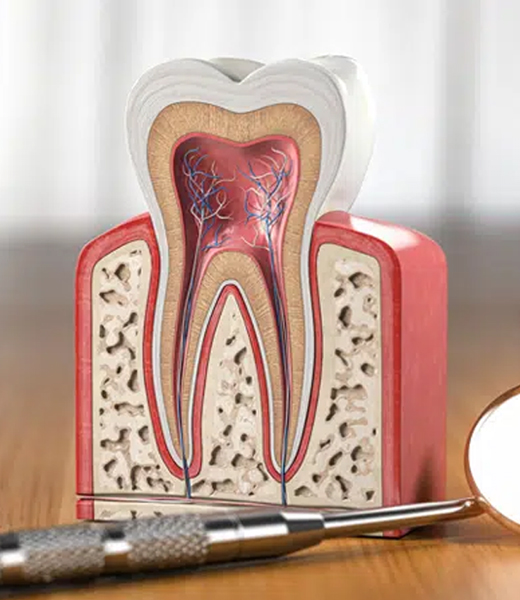Call Us Today : (757) 596-6850
Periodontal Disease, Causes, Diagnosis, and Treatment
Periodontal disease attacks the gums and the bone that support the teeth. Plaque is a sticky film of food debris, bacteria, and saliva. If plaque is not removed, it turns into calculus (tartar). When plaque and calculus are not removed, they destroy the gums and bone. Periodontal disease is characterized by red, swollen, and bleeding gums.

Four out of five people have periodontal disease and don’t know it! Most people are unaware of it because the disease is usually painless in the early stages.
Not only is it the number one reason for tooth loss, but research also suggests that there may be a link between periodontal disease and other diseases such as stroke, bacterial pneumonia, diabetes, cardiovascular disease, and increased risk during pregnancy. Smoking also increases the risk of periodontal disease.
Good oral hygiene, a balanced diet, and regular dental visits can help reduce your risk of developing periodontal disease.
What is Periodontal (Gum) Disease?
Periodontal disease (also known as periodontitis and gum disease) is a common inflammatory condition that affects the supporting and surrounding soft tissues of the tooth.
Periodontal disease is most often preceded by gingivitis, a bacterial gum tissue infection without bone loss. A bacterial infection affects the gums when the toxins contained in plaque begin to irritate and inflame the gum tissues. Once this bacterial infection colonizes in the gum pockets between the teeth, removing and treating it becomes much more difficult. Periodontal disease is a progressive condition. If left untreated, it can cause shifting teeth, loose teeth, and eventually tooth loss.
Periodontal disease is the leading cause of tooth loss among adults in the developed world and should always be promptly treated.
Causes Of Periodontal Disease
Gum disease begins with the inflammation and irritation of the gingival tissues surrounding and supporting the teeth. The cause of this inflammation is the toxins found in plaque which cause an ongoing bacterial infection.
The bacterial infection colonizes the gingival tissue, and deep pockets form between the teeth and the gums. If treated promptly the effects of mild inflammation (known as gingivitis) are completely reversible. However, periodontal disease destroys the gums and the underlying bone if the bacterial infection progresses, promoting tooth loss.

Other Contributing Factors of Periodontal Disease:
Poor dental hygiene: Preventing dental disease starts at home with good oral hygiene and a balanced diet. Prevention also includes regular dental visits, which include exams, cleanings, and X-rays. Excellent home care and professional dental care will preserve the natural dentition and support of bony structures. When bacteria and calculus (tartar) are not removed, the gums and bone around the teeth become affected by bacterial toxins. They can cause gingivitis or periodontitis, which ultimately leads to tooth loss.
Tobacco use: Research has indicated that smoking and tobacco use are some of the most significant factors in the development and progression of gum disease. In addition to smokers experiencing a slower recovery and healing rate, smokers are far more likely to suffer from calculus (tartar) build-up on teeth, deep pockets in the gingival tissue, and significant bone loss.
Genetic predisposition: Despite practicing rigorous oral hygiene routines, as much as 30% of the population may have a strong genetic predisposition to gum disease. These individuals are six times more likely to develop periodontal disease than individuals without a genetic predisposition. Therefore, genetic tests, such as Oral DNA, can determine susceptibility, and early intervention can be performed to keep the oral cavity healthy. Oral DNA is a test used to find hidden oral pathogens that threatens your oral and systemic health. It can tell us what you are at risk for such cardiovascular disease, strokes, and Alzheimer's disease. This test can tell us more about your oral health than meets the eye and help us customize your periodontal care to your specific needs.

Pregnancy and menopause: During pregnancy, regular brushing and flossing are critical. Hormonal changes experienced by the body can cause the gum tissue to become more sensitive, rendering them more susceptible to gingivitis, as well as gum disease
Chronic stress and poor diet: Stress lowers the ability of the immune system to fight off disease, which means bacterial infection can beat the body’s defense system. Poor diet or malnutrition can also lower the body’s ability to fight periodontal infections, negatively affecting the health of the gums.
Diabetes and underlying medical issues: Many medical conditions can intensify or accelerate the onset and progression of gum disease, including respiratory disease, heart disease, arthritis, and osteoporosis. Diabetes hinders the body’s ability to utilize insulin, making the bacterial infection in the gums more difficult to control and cure.
Bruxism: The clenching or grinding of teeth can significantly damage the supporting tissue surrounding the teeth. When an individual is suffering from gum disease, the additional destruction of gingival tissue due to grinding can accelerate the progression of the disease.
Medication: Many drugs, including oral contraceptive pills, heart medicines, anti-depressants, and steroids, affect the overall condition of teeth and gums, making them more susceptible to gum disease. Steroid use promotes gingival overgrowth and allows bacteria to colonize more readily in the gum tissue.
Signs And Symptoms Of Periodontal Disease:
Bleeding gums
Loose teeth
New spacing between teeth
Persistent bad breath
Exudate around the teeth and gums
Receding gums
Red and Swollen gums
Tenderness or Discomfort
Periodontal Disease Diagnosis

Our dentist or dental hygienist diagnoses periodontal disease during a periodontal examination. This type of exam should always be part of your regular dental check-up.
A periodontal probe (small dental instrument) is gently used to measure the sulcus (pocket or space) between the tooth and the gums. The depth of a healthy sulcus measures three millimeters or less and does not bleed. The periodontal probe helps indicate if pockets are deeper than three millimeters. As periodontal disease progresses, the pockets usually get deeper.
Your dentist or hygienist will use pocket depths, amount of bleeding, inflammation, tooth mobility, etc., to make a diagnosis that will fall into the category below:
Periodontal Treatment Methods
Periodontal treatment methods depend upon the type and severity of the disease. Our dentist and dental hygienist will evaluate for periodontal disease and recommend the appropriate treatment.
When deeper periodontal pockets are present a special periodontal cleaning called scaling and root planing (deep cleaning) will be recommended. It is usually done in one quadrant of the mouth at a time while the area is numb. In this procedure, tartar, plaque, and toxins are removed from above and below the gum line (scaling), and rough spots on root surfaces are made smooth (planing). This procedure helps gum tissue to heal and pockets to shrink. Medications, special medicated mouth rinses, and an electric toothbrush may be recommended to help control infection and healing.
In addition to scaling and root planing, Arestin, an antibiotic that is designed specifically to fight the bacteria that causes periodontal disease, may be used.
Periodontal Maintenance
It only takes twenty-four hours for plaque not removed from your teeth to turn into calculus (tartar)! Daily home cleaning helps control plaque and tartar formation, but those hard-to-reach areas always need special attention.
Once your periodontal treatment has been completed, our dentist and dental hygienist will recommend that you have periodontal maintenance cleanings, usually four times a year. At these cleaning appointments, the pocket depths will be carefully checked to ensure they are healthy. In addition, plaque and calculus that are difficult for you to remove daily will be removed from above and below the gum line.
Periodontal maintenance is a deeper, more involved cleaning than a standard prophylaxis. Our hygienists use specialized instruments and clean below the gumline. We also use an anti-bacterial irrigation to help reduce the amount of bacteria. Once your periodontal disease is stable, PerioProtect is introduced. PerioProtect is a minimally invasive, at-home treatment of your periodontal disease. Perio medication fel is dispensed into trays designed to deliver the medication deep into periodontal pockets to help maintain and prevent periodontal issues from reoccurring. An added benefit of this product is a whiter and brighter smile.





